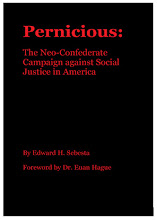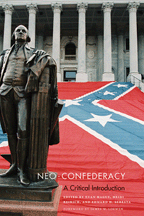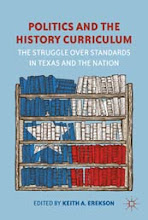When I say when the
New York Times was pro-neo-Confederate I don't want to imply that it doesn't have sympathies with the Confederacy today.
This is a short item from
The Southern Magazine, April-May 1934, Vol. 1 No. 2, "Mississippi Edition," which was published by the United Daughters of the Confederacy (UDC). Individual issues were often dedicated to a state or a region.
On page 28 is the section titled, "The Main Street of the South," by Anne V. Mann. One of the articles is titled, "Southern Society Pays Honor to Five.
The text of the article as to the
New York Times is as follows:
The New York Times of March 3rd says:
Five persons who "contributed unusual achievements in the perpetuation of the history and traditions of the South" during 1933 received parchments of distinction from the New York Southern Society last night at its annual Dixie dinner dance at the Waldorf-Astoria.
[The article mentions Mrs. Livingston Rowe Schuyler as one recipient then continues.]
Adolph S. Ochs, publisher of The New York Times, was honored as "a greater leader in journalism and in public life, whose lofty and patriotic career reflects such credit upon the South." The parchment was accepted by his daughter, Mrs. Arthur Hays Sulzterger, representing Mr. Ochs, who was unable to attend.
[The article then goes on to list the other recipients.]
It is not surprising that the New York Southern Society gave Ochs an award. Ochs gave a neo-Confederate rendering of the news as the
Confederate Veteran reported in a 1903 article. I boldface the relevant section in this part of the article.
The New York Times, one day's issue, includes; The news section, 28 pages, the annual financial supplement, 56 page: the quotation supplement, 4 pages; the magazine supplement, 16 pages; the magazine section 6 pages; the winder resort section, 8 pages -- total, 118 pages.
A few years ago the New York Times, with all its prestige was about to succumb. At that critical period, Mr. Adolph S. Ochs, as thoroughly "self-made" as any American, with experience in the Chattanooga Times, beginning in his boyhood, had ambition for the ownership of that venerable New York daily, and securing the cooperation of friends, he assumed the responsibility, and determined to publish "all the news fit to print" on conservative, dignified lines. It was a prodigious undertaking, and Mr. Ochs won.
The feature of this enterprise of interest to VETERAN Readers is that the Southern people may read the New York Times with perfect satisfaction. They get the news reliably all the time with never a word of discredit upon their section. [Confederate Veteran, Vol. 11 No. 1, Jan. 1903, page 40.]
Given the time period at which Ochs was publishing the
New York Times it was a paper that was opposed to civil rights and supportive of white supremacy. The
Confederate Veteran continued to mention the New York Times and Ochs favorably in larger articles with his picture and a half page picture of the
New York Times' skyscraper and informing the reader that Ochs and the paper were in alignment with Southern opinion.
From a 1905 article:
The New York Times was in ""hard lines" when Mr. Ochs bought it, and now it is not only far beyond any question of reliability but, better still, it is one of the most conservative and one of the ablest newspapers printed. Indeed, it rarely misses giving "all the news fit to print." Mr. Ochs's southern friends rarely have a wish that is not developed in the New York Times. [Confederate Veteran, Vol. 13 No. 12, Dec. 1905, pages 578-578]
Adolph S. Ochs was a supporter of the Lost Cause. He donated $1,000 to the Lee Mausoleum Custodian Endowment Fund in Virginia in memory of his departed mother. [
Confederate Veteran, Vol. 35 No. 3, March 1927, page 112.]
It turns out that though his father was a Captain in the Union army his mother smuggled quinine into Kentucky for the use by the Confederacy. His mother, Barbara Levy Ochs was a "devoted" member of the A.P. Stewart Chapter of the UDC. Her brother was in the Confederate army. [
Confederate Veteran, Vol. 36 No. No. 5, May 1925, page 164.]
It might well be a good project to see how this identification with the Confederacy affected the
New York Times' reporting and publishing.







